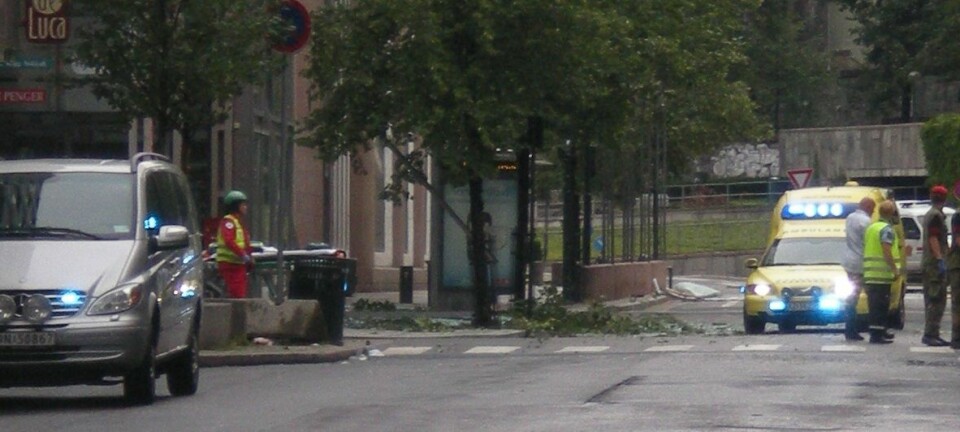
Hospital describes experiences after last year's Oslo terrorist attack
On 22 July 2011, an extreme right-wing domestic terrorist car-bombed key government buildings in Oslo and shot down dozens of youths at a nearby Labour Party camp. A recent report explains how smart decision-making and interaction between the staff of hospital ERs and emergency services saved many lives.
Denne artikkelen er over ti år gammel og kan inneholde utdatert informasjon.
On a Friday afternoon when many public servants had left work for the weekend and a fair share of staff were on summer holiday, the trauma centre at Oslo University Hospital (OUS) suddenly found itself dealing with the most devastating and massive attack in Norway since World War II.
A group of doctors and nurses who treated the terror victims have now assessed their efforts at the trauma centre.
Their report was recently published in the Journal of Trauma and Acute Care Surgery.
Over 100 operations
OUS is an amalgamation of several hospitals in the capital and it’s Norway’s largest. It also has the country’s biggest trauma centre − in an average year accepting about 1,500 emergency patients.
In this two-staged attack 77 people were killed and more than 220 people were injured.
The trauma centre at OUS immediately admitted ten people from the explosion downtown and later 21 more from the island Utøya, a total of 31 patients.
Twenty-five of the patients required multiple operations, and surgeons at OUS carried out 125 operations on the victims in the first four weeks after 22 July.
One life couldn’t be saved by the trauma team because the patient’s injuries were just too severe.
This was the only one of the 22 July victim who died in hospital.
Short distance to hospitals
In the newly published report, the short distance from the bomb attack to hospitals is listed as a reason why the mortality rate among severely injured hospital patients was so low.
The bomb went off right outside the high-rise building housing the prime minister’s office, which is just a quick ambulance drive from OUS emergency wards.
Fortunately the city’s blood bank had sufficient supplies.
A record number of people volunteered to donate blood following the attacks on 22 July.
However, this eagerness waned within a few months and the Norwegian Red Cross had to call for more blood donors earlier this year.
Not overwhelmed
Despite the huge number of patients and operations required, by Oslo standards, surgical capacity was never swamped, neither at the ERs, the operating rooms or the intensive care wards, the main author Christine Gaarder and her co-authors write in the report.
The powerful car bomb exploded at 15:25 at the Norwegian Government Quarter. At 15:41 the OUS crisis plan had been implemented.
One of its provisions involved directing patients with less severe injuries to peripheral hospitals so the trauma centre could focus on the victims who were worst off.
This also enabled the hospitals to schedule operations and examinations to daytime hours and the patients could have the same doctors all along, which ensured a better continuity of treatment.
The plan detailed the distribution of roles and all the trauma centre personnel knew who they reported to and what their concrete responsibilities were.
Revision of crisis plan
Key responsibility for the centre was divided between two people. They established slightly different roles with regard to control and supervision of the patients and hospital staff − a dualistic division of responsibility.
This distribution of management responsibilities had not been stipulated in the crisis plan. But according to the new report it will be implemented in the hospital’s revised plan along with more detailed descriptions of key roles.
Utøya, where the Labour Party summer camp was held, is in a large lake about 40 km northwest of Oslo. The report points out that nine gunshot victims who should have been sent directly to the OUS were initially taken to local hospitals because of logistics problems.
However, these were shuttled to OUS later in the same day.
The basis for data used in the report consists mainly of patient journals and notes the medical personnel documented about the patients, for instance time of arrival, when they were transferred if at all, the extent of their injuries and the treatment they received.
Self-evaluation
The OUS health personnel assess their own performances in this report.
A few months ago a ScienceNordic affiliate interviewed the air ambulance doctor and researcher Stephen Sollid, who said that the conclusions in such reports should be viewed in light of their overt deficiencies and it must be remembered that the researchers are to a certain extent observing and examining themselves.
“However, there is a good precedent for such descriptive studies – or reports if you like – being published in the aftermath of such incidents, so professionals in the field internationally can draw conclusions and learn from the experiences made during the incident,” he said.
Read the full story in Norwegian at forskning.no
Translated by: Glenn Ostling

































